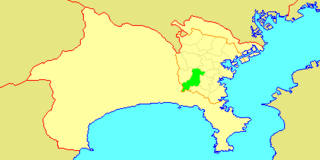This article needs additional citations for verification .(August 2012) (Learn how and when to remove this template message) |
| Atsugi 厚木市 | |||
|---|---|---|---|
| Special city | |||
 Atsugi City Hall | |||
| |||
 Location of Atsugi in Kanagawa Prefecture | |||
| Coordinates: 35°26′00″N139°22′00″E / 35.43333°N 139.36667°E Coordinates: 35°26′00″N139°22′00″E / 35.43333°N 139.36667°E | |||
| Country | Japan | ||
| Region | Kantō | ||
| Prefecture | Kanagawa Prefecture | ||
| District | Aikō (formerly) | ||
| Area | |||
| • Total | 93.83 km2 (36.23 sq mi) | ||
| Population (June 1, 2012) | |||
| • Total | 224,462 | ||
| • Density | 2,390/km2 (6,200/sq mi) | ||
| Time zone | Japan Standard Time (UTC+9) | ||
| - Tree | Maple | ||
| - Flower | Rhododendron indicum | ||
| Phone number | 046-223-1511 | ||
| Address | 3-17-17 Nakacho, Atsugi-shi, Kanagawa-ken 243-8511 | ||
| Website | www.city.atsugi.kanagawa.jp | ||



Atsugi(厚木市Atsugi-shi) is a city located in Kanagawa Prefecture, Japan.

A city is a local administrative unit in Japan. Cities are ranked on the same level as towns and villages, with the difference that they are not a component of districts. Like other contemporary administrative units, they are defined by the Local Autonomy Law of 1947.

Kanagawa Prefecture is a prefecture located in Kantō region of Japan. The capital of the prefecture is Yokohama. Kanagawa is part of the Greater Tokyo Area. Kanagawa Prefecture is home to Kamakura and Hakone, two popular side trip destinations from Tokyo.

Japan is an island country in East Asia. Located in the Pacific Ocean, it lies off the eastern coast of the Asian continent and stretches from the Sea of Okhotsk in the north to the East China Sea and the Philippine Sea in the south.
Contents
- Geography
- Surrounding municipalities
- History
- Economy
- Transportation
- Railroad
- Highway
- Sister City relations
- Local attractions
- Other institutions
- Notable people from Atsugi
- References
- External links
As of June 2012, the city has an estimated population of 224,462, and a population density of 2,390 persons per km². The total area is 93.83 km².

In biology, a population is the number of all the organisms of the same group or species, which live in a particular geographical area, and have the capability of interbreeding. The area of a sexual population is the area where inter-breeding is potentially possible between any pair within the area, and where the probability of interbreeding is greater than the probability of cross-breeding with individuals from other areas.

Population density is a measurement of population per unit area or unit volume; it is a quantity of type number density. It is frequently applied to living organisms, and most of the time to humans. It is a key geographical term. In simple terms population density refers to the number of people living in an area per kilometer square.
While the name "Atsugi" is often associated with the United States Navy base named Naval Air Facility Atsugi, the base is actually not in Atsugi, but straddles the border between the nearby cities of Ayase and Yamato.

The United States Navy (USN) is the naval warfare service branch of the United States Armed Forces and one of the seven uniformed services of the United States. It is the largest and most capable navy in the world and it has been estimated that in terms of tonnage of its active battle fleet alone, it is larger than the next 13 navies combined, which includes 11 U.S. allies or partner nations. with the highest combined battle fleet tonnage and the world's largest aircraft carrier fleet, with eleven in service, and two new carriers under construction. With 319,421 personnel on active duty and 99,616 in the Ready Reserve, the Navy is the third largest of the service branches. It has 282 deployable combat vessels and more than 3,700 operational aircraft as of March 2018, making it the second largest and second most powerful air force in the world.

Naval Air Facility Atsugi is a naval air base located in the cities of Yamato and Ayase in Kanagawa Prefecture, Japan. It is the largest United States Navy (USN) air base in the Pacific Ocean and houses the squadrons of Carrier Air Wing Five (CVW-5), which deploys with the aircraft carrier USS Ronald Reagan.

Ayase is a city located in Kanagawa Prefecture, Japan. It is on the east bank of the Sagami River, and is bordered by Yamato, Fujisawa and Ebina cities. It should not be confused with a neighborhood of the same name in the special ward of Adachi, Tokyo.

























